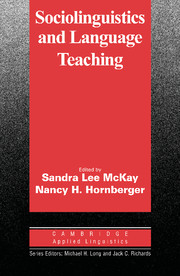Part IV - LANGUAGE AND CULTURE
Published online by Cambridge University Press: 22 July 2009
Summary
The foregoing three chapters emphasize the emergent and socially and culturally situated nature of interaction and the role that specific features of communication play therein. Throughout all three chapters, the theme of the individual as a communicative actor drawing on a range of linguistic resources in specific social situations stands out. We will turn now to a consideration of larger units of communicative interaction and how participants' social and cultural identities are played out there.
Muriel Saville-Troike, in “The Ethnography of Communication,” opens this part with an overview of the basic concepts, methods, and language teaching applications of the ethnography of communication, a research approach which was inaugurated in 1962 by Dell Hymes and which undergirds all the approaches and areas of study covered in Parts 3 and 4 of this volume. Saville-Troike begins by identifying the principal concerns of this approach as being the relationship of language form and use to patterns and functions of communication, to world view and social organization, and to linguistic and social universals and inequalities. She goes on to review such basic sociolinguistic concepts as speech community, communicative repertoire, and communicative competence as they evolved and came to be defined in the ethnography of communication, as well as the characteristic methods and the units of analysis of ethnographic research into communication – communicative (or speech) situation, communicative (or speech) event, and communicative (or speech) act.
- Type
- Chapter
- Information
- Sociolinguistics and Language Teaching , pp. 349 - 350Publisher: Cambridge University PressPrint publication year: 1995



